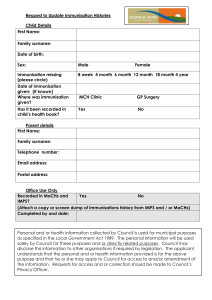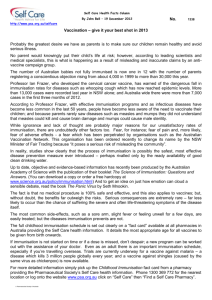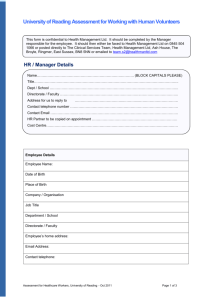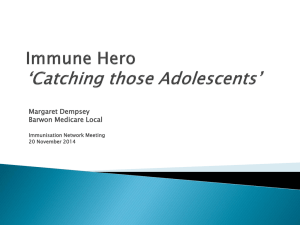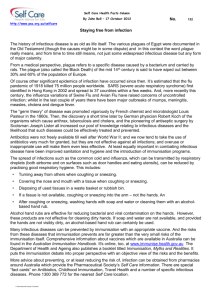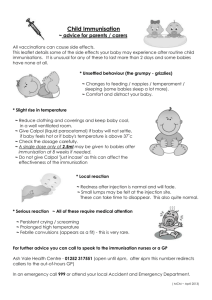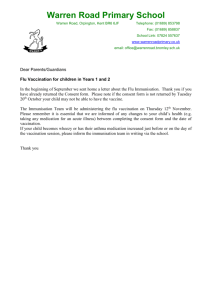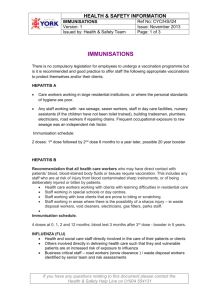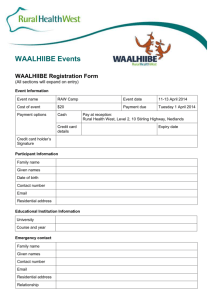Protecting with immunization - World Health Organization, South
advertisement
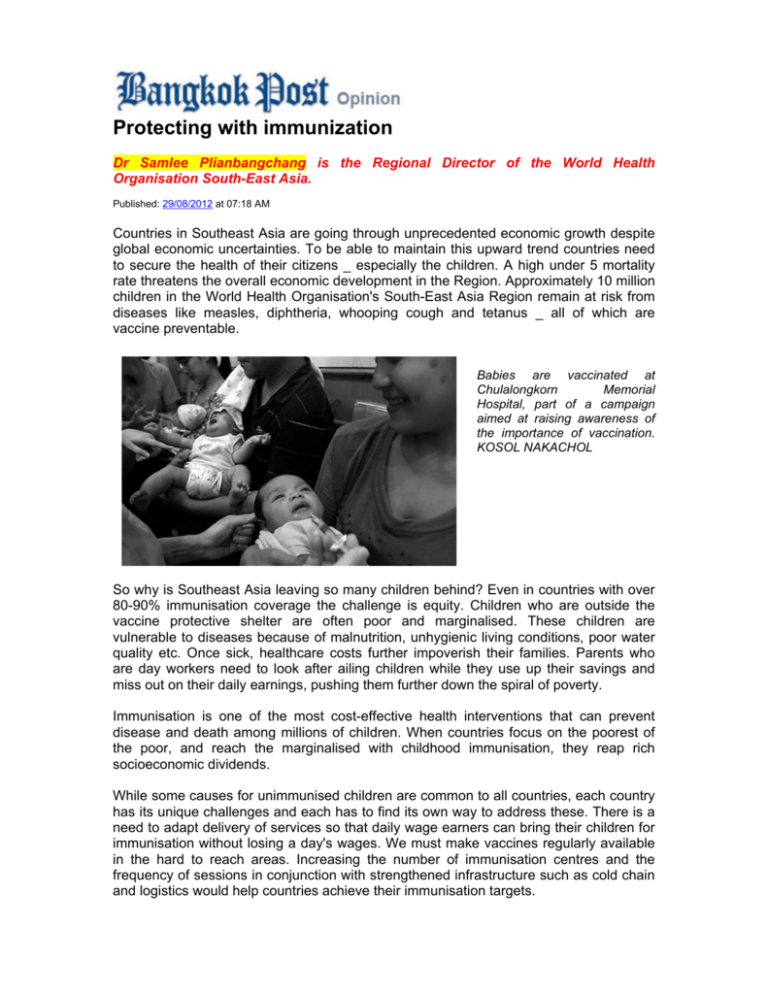
Protecting with immunization Dr Samlee Plianbangchang is the Regional Director of the World Health Organisation South-East Asia. Published: 29/08/2012 at 07:18 AM Countries in Southeast Asia are going through unprecedented economic growth despite global economic uncertainties. To be able to maintain this upward trend countries need to secure the health of their citizens _ especially the children. A high under 5 mortality rate threatens the overall economic development in the Region. Approximately 10 million children in the World Health Organisation's South-East Asia Region remain at risk from diseases like measles, diphtheria, whooping cough and tetanus _ all of which are vaccine preventable. Babies are vaccinated at Chulalongkorn Memorial Hospital, part of a campaign aimed at raising awareness of the importance of vaccination. KOSOL NAKACHOL So why is Southeast Asia leaving so many children behind? Even in countries with over 80-90% immunisation coverage the challenge is equity. Children who are outside the vaccine protective shelter are often poor and marginalised. These children are vulnerable to diseases because of malnutrition, unhygienic living conditions, poor water quality etc. Once sick, healthcare costs further impoverish their families. Parents who are day workers need to look after ailing children while they use up their savings and miss out on their daily earnings, pushing them further down the spiral of poverty. Immunisation is one of the most cost-effective health interventions that can prevent disease and death among millions of children. When countries focus on the poorest of the poor, and reach the marginalised with childhood immunisation, they reap rich socioeconomic dividends. While some causes for unimmunised children are common to all countries, each country has its unique challenges and each has to find its own way to address these. There is a need to adapt delivery of services so that daily wage earners can bring their children for immunisation without losing a day's wages. We must make vaccines regularly available in the hard to reach areas. Increasing the number of immunisation centres and the frequency of sessions in conjunction with strengthened infrastructure such as cold chain and logistics would help countries achieve their immunisation targets. Realising the impact of this equity gap on childhood immunisations, 11 countries in the WHO's South-East Asia Region have decided to focus their efforts on children in areas where the routine immunisation coverage is below 80%. Conflict and violence have frustrated efforts of some countries to reach and immunise children. Sri Lanka which has an overall national average of 100% coverage is now focusing its immunisation efforts on the two northern districts were severely affected by conflict. Thailand with a high 98% national coverage was earlier unable to provide full immunisation cover to three of its southernmost provinces of Pattani, Yala, and Narathiwat due to security conditions. It is now committed to focusing on these districts. Focusing immunisation efforts can make a big difference as has been seen in Bangladesh. Bangladesh has successfully reduced its under 5 morality by integrating efforts, including immunisation, and focusing on its very young children. With 80% vaccination coverage throughout the country, Bangladesh has now decided to give a push to routine immunisation in 31 districts and 4 city corporations that needed additional assistance for increasing and sustaining coverage. Geographic factors impact immunisation coverage in several countries. Nepal is reaching out to 33 of its 75 districts with intensified immunisation efforts and has hired additional vaccinators to reach them. These districts include those in far-flung mountainous areas and some lie in the Terai belt. The challenges before Indonesia and India are somewhat similar. These countries are among the most populous and are home to over half the birth cohort of the WHO's South-East Asia Region. In Indonesia providing uniform immunisation services to populations scattered over 30 000 islands is both costly and logistically challenging. For India the biggest challenge lies in the size of its population, including the large number of migrant populations. India is applying best practices from its vast Polio Eradication programme to intensify routine immunisation. These practices include mapping of migrant populations and risk assessments to guide actions and priorities. India is also providing increased priority for vaccine safety and security. State-level efforts are being made to strengthen the surveillance and reporting of adverse events following immunisation which could otherwise erode public confidence. Countries are also facing difficulties in financing the routine and new vaccines selected by them for inclusion in their national immunisation schedules. It is vital that adequate funds are allocated for these vaccines. Inequity in health services slows down a country's economic progress. Immunisation is an important tool in our arsenal to prevent death and disease in children. The time has come to invest in equity to ensure continued socioeconomic development in Southeast Asia. http://www.bangkokpost.com/opinion/opinion/309803/protecting-the-weak-withimmunisation Yogyakarta to Host Health Conference Dessy Sagita | August 29, 2012 Yogyakarta is preparing to host a meeting of health ministers from 11 Asian countries who will discuss the most important health issues facing the region. Convened by the World Health Organization, the 30th Meeting of Health Ministers of the Region will run Sept. 4-7. The forum will be a chance to exchange political, social and economic strategies from the point of view of the health sector. “There will be many issues discussed during the event, especially the control of diseases, contagious or not,” said Tjandra Yoga Aditama, the Health Ministry’s director general for disease control and environmental health. He said Indonesia exerted a major influence over the region’s health sector, with other countries in Southeast Asia taking note and following its example. “Indonesia’s voice is influential because we are the country with the largest population in SEARO,” Tjandra said, referring to the Southeast Asian Regional Office of the WHO. Other countries grouped in SEARO are Bangladesh, Bhutan, East Timor, India, Maldives, Myanmar, Nepal, North Korea, Sri Lanka and Thailand. Some of the key issues expected to be discussed at the gathering are the eradication of polio, preparation for an influenza pandemic and routine immunizations. The conference will also focus on regional health issues, and the strengthening of policies to overcome non-contagious diseases, which can still be deadly. Indonesia continues to face many health problems, including a paltry 83 percent coverage for basic immunizations. Tjandra said 100 percent coverage would be difficult to achieve because of the country’s difficult geography as well as the rise of anti-immunization campaigns by groups pushing different agendas. In 2011, 11.5 million children in the country were immunized against measles as part of an additional, non-routine immunization campaign. The Health Ministry has set a target to have 100 percent of the population immunized against polio, measles, hepatitis B, tetanus and tuberculosis by 2014. Indonesia is also struggling to overcome avian influenza, or bird flu. Through the middle of August, 191 people in Indonesia have tested positive for avian influenza since 2005, with 159 deaths. These figures are the highest in the world where at least 300 people have died from the disease since 2005. Another pressing health issue is the rise of non-contagious diseases like cancer, heart disease and diabetes, which now account for the largest number of deaths in Indonesia. The death rate from non-contagious diseases has risen from 41.7 percent in 1995 to 49.9 percent in 2001 and 59.5 percent in 2007. Stroke remains the top killer, accounting for 15.4 percent of deaths, followed by hypertension, diabetes, cancer and chronic obstructive lung disease. Deaths from these non-contagious disease are seen both in urban and rural areas around the country. http://www.thejakartaglobe.com/health/yogyakarta-to-host-health-conference/540874 Menkes 11 Negara Asia akan Bertemu di Yogya Jumat, 31/08/2012 - 03:32 JAKARTA, (PRLM). - Para Menteri dan pakar kesehatan dari negara-negara Asia Tenggara akan bertemu di Yogyakarta, pada 4-7 September 2012 dalam WHO Regional Committee and Health Minister's Meeting Kawasan Asia Tenggara, untuk membicarakan isu-isu penting tentang kesehatan di kawasan ini. Communications Officer, WHO Country Office for Indonesia Nursila Dewi, dalam keterangannya di Jakarta, menyampaikan, pertemuan Menteri Kesehatan Asia Tenggara yang ke-30 ini adalah forum pertukaran pengalaman dan strategi nasional dari sisi politik, sosial dan ekonomi. Pertemuan tersebut diikuti dengan Pertemuan Komite Regional (Regional Committee) Badan Kesehatan Dunia (WHO) Kawasan Asia Tenggara. Komite Regional adalah kelompok yang beranggotakan negara-negara anggota WHO di kawasan tertentu, dalam hal ini Asia Tenggara, yang bertemu setahun sekali untuk menilai kemajuan dan penerapan resolusi-resolusi pertemuan negara anggota WHO sedunia (World Health Assembly). Diagendakan Dr Samlee Plianbangchang, Direktur WHO untuk Kawasan Asia Tenggara akan menghadiri acara tersebut, yaitu 30th Meeting of Ministers of Health of countries of South-East Asia Region dan 65th Session of the WHO Regional Committee for South-East Asia. Negara-negara yang termasuk dalam kawasan Asia Tenggara (South East Asia Region disingkat SEAR) berdasar pembagian WHO adalah Bangladesh, Bhutan, Korea Utara, India, Indonesia, Maldives, Myanmar, Nepal, Sri Lanka, Thailand dan Timor-Leste. (kominfo/A-26).*** http://www.pikiran-rakyat.com/node/201578 Tuesday 04 September 2012 Immunisation is key to development By Samlee Plianbangchang, Sep 4, 2012 India is applying best practices from its vast polio eradication programme to inten-sify immunisation. Countries in South-East Asia are going through unprecedented economic growth despite uncertainties in the global economic situation. To be able to maintain this upward trend, countries need to secure the health of their citizens – especially the children. A high under 5 mortality rate threatens the overall economic development in the Region. Approximately 10 million children in WHO’s South-East Asia region remain at risk from diseases like measles, diphtheria, whooping cough and tetanus – all of which are vaccine preventable. So why is South-East Asia leaving so many children behind? Even in countries with over 8090 per cent immunisation coverage, the challenge is equity. Children who are outside the vaccine protective shelter are often poor and marginalised. These children are vulnerable to diseases because of malnutrition, unhygienic living conditions, poor water quality etc. Once sick, health-care costs further impoverish their families. Parents who are day workers need to look after ailing children while they use up their savings and miss out on their daily earnings, pushing them further down the spiral of poverty. Immunisation is one of the most cost-effective health interventions that can prevent disease and death among millions of children. When countries focus on the poorest of the poor, and reach the marginalised with childhood immunisation, they reap rich socioeconomic dividends. Addressing challenges While some causes for unimmunised children are common to all countries, each country has its unique challenges and each has to find its own way to address these. There is a need to adapt delivery of services so that daily wage earners can bring their children for immunisation without losing a day’s wages. We must make vaccines regularly available in the hard to reach areas. Increasing the number of immunisation centres and the frequency of sessions in conjunction with strengthened infrastructure such as cold chain and logistics would help countries achieve their immunisation targets. Realising the impact of this equity gap on childhood immunisations, 11 countries in WHO’s South-East Asia region have decided to focus their efforts on children in areas where the routine immunisation coverage is below 80 per cent. Conflict and violence have frustrated efforts of some countries to reach and immunise children. Sri Lanka which has an overall national average of 100 per cent coverage is now focusing its immunisation efforts on the two northern districts were severely affected by conflict. Thailand with a high 98 per cent national coverage was earlier unable to provide full immunisation cover to three of its southernmost provinces of Pattani, Yala, and Narathiwat due to security conditions. It is now committed to focusing on these districts. Focusing immunisation efforts can make a big difference as has been seen in Bangladesh. Bangladesh has successfully reduced its under 5 morality by integrating efforts, including immunisation, and focusing on its very young children. With 80 per cent vaccination coverage throughout the country, Bangladesh has now decided to give a push to routine immunisation in 31 districts and 4 city corporations that needed additional assistance for increasing and sustaining coverage. Geographic factors impact immunisation coverage in several countries. Nepal is reaching out to 33 of its 75 districts with intensified immunisation efforts and has hired additional vaccinators to reach them. These districts include those in far-flung mountainous areas and some lie in the Terai belt. The challenges before Indonesia and India are somewhat similar. These countries are among the most populous and are home to over half the birth cohort of WHO’s South-East Asia region. In Indonesia, providing uniform immunisation services to populations scattered over 13,000 islands is both costly and logistically challenging. For India the biggest challenge lies in the size of its population, including the large number of migrant populations. India is applying best practices from its vast polio eradication programme to intensify routine immunisation. These practices include mapping of migrant populations and risk assessments to guide actions and priorities. India is also providing increased priority for vaccine safety and security. State-level efforts are being made to strengthen the surveillance and reporting of adverse events following immunisation (AEFI) which could otherwise erode public confidence. Countries are also facing difficulties in financing the routine and new vaccines selected by them for inclusion in their national immunisation schedules. It is vital that adequate funds are allocated for these vaccines. Inequity in health services slows down a country’s economic progress. Immunisation is an important tool in our arsenal to prevent death and disease in children. The time has come to invest in equity to ensure continued socioeconomic development in South-East Asia. (The writer is regional director, WHO South-East Asia) http://www.deccanherald.com/content/276240/immunisation-key-development.html 03 September 2012 6 September 2012 http://thehimalayantimes.com/fullNews.php?headline=Protecting+the+vulnerable+with+immunization+To+prevent+death+and+disea se&NewsID=346332
